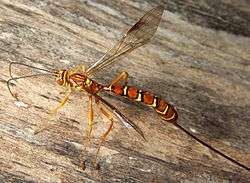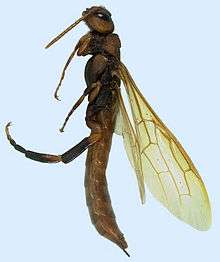Megarhyssa macrurus
| Megarhyssa macrurus | |
|---|---|
 | |
| Megarhyssa macrurus female | |
| Scientific classification | |
| Kingdom: | Animalia |
| Phylum: | Arthropoda |
| Class: | Insecta |
| Order: | Hymenoptera |
| Family: | Ichneumonidae |
| Subfamily: | Rhyssinae |
| Genus: | Megarhyssa |
| Species: | M. macrurus |
| Binomial name | |
| Megarhyssa macrurus (Linnaeus, 1771) | |
Megarhyssa macrurus (common name giant ichneumon wasp),[1] is a species of large ichneumon wasp.[2]
It is a predatory insect, notable for its extremely long ovipositor. It uses this to deposit an egg into a tunnel in dead wood bored by a similarly large species of horntail. Another of its common names is 'stump stabber' referring to this behaviour.[3]
Etymology
Macrurus is from the Greek words makrós (μακρός) meaning "long", and oùrá (οὐρά) meaning tail.[4]
Description
Megarhyssa macrurus has a reddish-brown body approximately 2 inches (51 mm) long. It has black and yellow-orange stripes.[1] Its wings are transparent and the body elongated. The female of this species has an ovipositor of approximately 4 inches (100 mm) in length.[5] Males are smaller (and have no ovipositor).[1]
The ovipositor
_(7686081848).jpg)
The ovipositor appears as a single filament, but it comprises three filaments. The middle filament is the actual ovipositor which is capable of drilling into wood. This middle filament looks like a single filament, but is made of two parts. These parts have a cutting edge at the tip. They interlock and slide against each other.
Although very thin, it is a tube and the egg moves down the minute channel in its center during egg laying. Two other thin filaments serve as protection for the ovipositor. They arc out to the sides during egg laying.[1]
Distribution
This species of wasp is found in various locations in the United States.[5]
Behaviour

Megarhyssa macrurus is considered harmless to humans;[1][6] they are parasitoids on the larvae of the pigeon horntail (Tremex columba, Symphyta), which bore tunnels in decaying wood. Female Megarhyssa macrurus are able to detect these larvae through the bark, and lay their eggs on them; within a couple of weeks, the Megarhyssa larvae will have consumed their host and pupate. They will emerge as an adult the coming summer.[1][5]
Subspecies
Subspecies include:[7]
- Megarhyssa macrurus icterosticta, Michener, 1939[8]
- Megarhyssa macrurus lunator
- Megarhyssa macrurus macrurus (Linnaeus, 1771)[8]
References
- 1 2 3 4 5 6 Pigeon Tremex Horntail and the Giant Ichneumon Wasp. Ext.colostate.edu (2010-05-12). Retrieved on 2010-12-17.
- ↑ Ichneumonid wasp, Megarhyssa macrurus (Hymenoptera: Ichneumonidae). Insectimages.org (2010-05-04). Retrieved on 2010-12-17.
- ↑ Bug of the Month July 2014: Female Stump Stabbers laying eggs!!!, What's That Bug. Accessed 2015-06-07
- ↑ Species Megarhyssa macrurus. BugGuide.Net. Retrieved on 2010-12-17.
- 1 2 3 Welcome to the BYGL Newsletter. Bygl.osu.edu. Retrieved on 2010-12-17.
- ↑ http://insects.tamu.edu/fieldguide/cimg327.html
- ↑ Ichneumon wasp. Insects.tamu.edu. Retrieved on 2010-12-17.
- 1 2 Essig Museum of Entomology Collections. Essigdb.berkeley.edu. Retrieved on 2010-12-17.